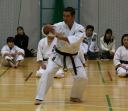``Sakamoto-kun, could you please create a Kata for Aiki and Tsue?
That's wonderful... because Karate has Kata... On the other hand, unfortunately, my Aiki does not have Kata... I want to create my own Kata of Aiki..."
These are the words I received from my Aiki-Jyujutsu Mater, Sugawara Gesshu.
Nage 15-ko
Even after I became uchi-deshi of Chitose Sensei, I continued to practice daily with these words as my homework.
One day, Chitose Sensei gave me a technique that solved all my problems at once.
I was surprised at the similarity between this technique and Gesshu's Aiki-jujutsu technique. In fact, it is "Nagenokata 15ko".
Hente has already worked on 15ko, so what I will focus on here is the creation of the Kata.
In fact, in the past, I had only performed it once under the name ``Nage no Kata'' at the Ryuseihai Tournament held at Kasukabe Budokan every year.
However, at that time, I only drew 15 movements, and looking back, I didn't reach a level that could be called ``Kata''.
As a reflection on that, I took the opportunity to create this cane shape to create two shapes from Kumibo I and II:
the Motokumi no kon and the Kumiuchi no kom, or the same Kata as the Useishi that Kanji Masutome Kanji sensei left behind as a recorded video.
I thought it would be great if I could create something as Enbukata.
I believe that the appropriate name for the kata is ``Gekkou/Moonlight,'' which connects the 15ko 15 to the moon of the 15th night,
and evokes the image of admiring the harvest moon of the 15th night on the seaside. I would like to perform it if I have a chance someday.
Creation of the Tsue Kata
The following is a summary of the process of creation.
Until now, I had not given much thought to the systematization of the Tsue technique, since it can be incorporated into the Bo (Kon) technique and practiced within it. However;
① Okinawa Kojo-ryu Karate incorporated cane practice of Tsue.
② The Tsue technique, like sumo, is derived from swordsmanship (Kenjyutsu) .
③ In the process of researching the relationship between Tenshinsho Jigen-ryu sword techniques and Tie,
I was able to create the Nuntyaku technique ``Happu Itsugyoku (eight winds and five tunes)'',
which expanded the range of karate techniques and the thoughts and philosophy of karate. There was a sense of depth.
Based on the above facts and considerations, I have decided to make Tsue's
techniques into a category like other weapon systems. And, similar to ③
above, I arrived at the creation of ``Ryuseishi no Tsue'' by referring
to the sword techniques of Tenshinsho Jigenryu (*).
(* Permission has been obtained from Ueno Kagenori Sensei, the head of
Tenshinsho Jigenryu)
The technique consists of three parts: "Basic (Kihon)", "Basic Kumiuchi", and "Gesshu no Kata". (October, 2023)
|


